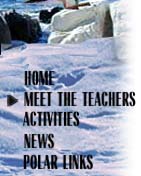
|
|
10 January, 2003
Today Dr. Chuck Amsler, my principal investigator, asked me to attend
a seminar he was giving to some students. It was wonderful. His
slide presentation of his past research ventures was spellbinding!
I can't wait to go to Antarctica and work with him! Chuck is very
enthusiastic about his work and it shows in his lectures. His slides
are vivid and as he speaks about what is on the screen, you feel you
are a part of his project. He is informative and is able to speak on
anyone's level of understanding. Chuck does not speak "over your
head." I wish everyone "out there" could get a chance to hear his
lecture. I am so excited to have been placed with Chuck and his
team. I feel so blessed to be a part of this project.
Chuck began talking about former research that his team had
accomplished at McMurdo Station on McMurdo Sound across the continent
from where we will be at Palmer Station. Scientists actually refer
to McMurdo as a town, because it really is a small town. During the
field season, there are about 1,100 people there. McMurdo has a fire
station, a store, and a church!
Chuck explained that in the shallow waters around McMurdo Sound, most
red algae do not lay upon the bottom of the sea as they are in other
places. They "hitch a ride" on the backs of sea urchins. This
surprised the scientists because elsewhere in the world, sea urchins
feed on red algae. Why do they not eat red algae here in Antarctica?
The scientists noticed that predators in Antarctica also did not eat
up sea urchins. They began to wonder, "Is there something about the
red algae here that makes them undesirable to eat?" As the
scientists conducted experiments, they found it was the chemical
composition of red algae in Antarctica that made them undesirable
for the urchins to eat while the algae act as a physical "shield"
that helps protect the urchins from their predators.
This is an example of mutualism. Mutualism is a scientific word that
is used to describe two or more organisms that thrive together and
both organisms benefit from the relationship. Sea urchins carrying
around red algae do not get eaten. Red algae benefits because they
are still able to grow and reproduce while using a sea urchin as a
home. If the red algae were unable to reproduce when attached to sea
urchins, they would eventually go extinct in this area.
Chuck brought us up-to-date with the research currently being
conducted by his team at Palmer Station on the Antarctic Peninsula.
Palmer Station sits on an island, Anver's Island. Here, Chuck and
his team have been researching another type of algae, brown algae.
It grows along the sea floor and looks like the giant kelp forests
off of the coast of California. The scientists wondered how the
brown algae gets so big in Antarctica. Again, they conducted
bioassays to uncover the chemical composition of the brown algae. It
was concluded that the brown algae, just the like the red algae on
another side of Antarctica, had a chemical composition that kept it
from being tasty to predators.
A "bioassay" is an abbreviation for biological assay. A biological
assay measures a biological response. Chuck's team conducts
"feeding bioassays" whereby what is being measured is the biological
response of feeding on something or not (or more or less on
something else). A bioassay could determine if something is toxic,
causes cancer, is a skin irritant, or is something that makes you
grow faster. In all cases you are measuring the biological response
of an organism in the assay. I learned another new vocabulary word
today, Sympatric. Sympatric simply means organisms living together
in the same environment.
Contact the TEA in the field at
.
If you cannot connect through your browser, copy the
TEA's e-mail address in the "To:" line of
your favorite e-mail package.
|
